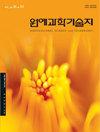灌水量对果实期和生育期EC水平对甜瓜生长和品质的影响椰泥基质水培法在秋季栽培中的应用
IF 0.8
4区 农林科学
Q3 HORTICULTURE
Korean Journal of Horticultural Science & Technology
Pub Date : 2021-08-01
DOI:10.7235/HORT.20210040
引用次数: 4
摘要
本研究以椰泥为基质,研究了不同灌水量对“结实期”的影响,以及不同生育期灌水量对甜瓜生长和果实性状的影响。按排水量(%)调节灌水量,定植后排水量为30%。“结实期”灌水量连续2个处理分别调节为10%和30%的排水率,结果期40 d后保持10%的排水率。灌水EC水平设为3个处理;低水平(1.0 ~ 1.5 ~ 1.8 dS·m -1)、中水平(1.5 ~ 1.8 ~ 2.0 dS·m -1)、高水平(1.8 ~ 1.8 ~ 2.3 dS·m -1)按开花期、结果期和结果后40 d进行排序。从排水EC的变化来看,灌水EC水平越低,排水EC水平越低,灌水量为30%的处理比灌水量为10%的处理值更低。结果表明:30%排水时叶长、叶宽、叶面积最高,灌水EC水平在结实期较高,但中层EC表现出相似的格局,差异不显著;因此,对于EC水平,中间水平(1.5-1.8-2.0 dS·m -1)似乎是最合适的。灌水量对果重、果高、果宽和果形的影响大于EC水平。而30%引流率组数值较高。不同生育期灌水EC水平的增加增加了植株的鲜重和干重,但果糖含量无显著差异。本研究结果表明,采用椰壳基质水培“PMR Worldstar”网瓜时,30%的排水率对果实生长更为有利本文章由计算机程序翻译,如有差异,请以英文原文为准。
Effects of Irrigation Amount on Fruiting Period and EC Level by Growth Period on Growth and Quality of Melon (Cucumis melo L.) Using Coir Substrate Hydroponics During Autumn Cultivation
This study was performed to identify the effects of changes in irrigation amounts on the ‘fruiting period’ and of irrigation electrical conductivity (EC) level by the growth period on the growth and fruit properties of melon in hydroponics, using coir substrate. The irrigation amount was regulated based on the drainage rate (%), which was 30% after transplanting. The irrigation amount during the ‘fruiting period’ was regulated to the drainage rate of 10% and 30% for the two consecutive treatments of the irrigation level, and after 40 days of fruiting, the drainage rate was maintained at an equal level of 10%. The irrigation EC level was set to three treatments; low level (1.0-1.5-1.8 dS·m -1 ), middle level (1.5-1.8-2.0 dS·m -1 ), and high level (1.8-1.8-2.3 dS·m -1 ), according to the three growth periods: flowering period, fruiting period, and 40 days after fruiting. For the changes in drainage EC, a low irrigation EC level indicated a low drainage EC level, while a lower value was shown by the 30% drainage treatment with a higher irrigation amount than by the 10% drainage treatment. The results show that leaf length, leaf width, and leaf area were the highest at 30% drainage and the irrigation EC level on the fruiting period was high, but the middle level EC showed a similar pattern without a significant difference. Thus, for the EC level, the middle level (1.5-1.8-2.0 dS·m -1 ) appears to be most suitable. The irrigation amount had more influence on fruit weight, fruit height, fruit width, and fruit shape than the EC level. Meanwhile, the 30% drainage rate group showed higher values. An increase in the irrigation EC level by growth period was found to have increased the fresh and dry weights of the plant, although the fruit sugar content showed no significant difference. The findings of this study suggest that for the hydroponics of the net melon ‘PMR Worldstar’ using coir substrate, a 30% drainage rate was more favorable for melon fruit
求助全文
通过发布文献求助,成功后即可免费获取论文全文。
去求助
来源期刊
CiteScore
2.00
自引率
0.00%
发文量
0
审稿时长
1 months
期刊介绍:
Horticultural Science and Technology (abbr. Hortic. Sci. Technol., herein ‘HST’; ISSN, 1226-8763), one of the two official journals of the Korean Society for Horticultural Science (KSHS), was launched in 1998 to provides scientific and professional publication on technology and sciences of horticultural area. As an international journal, HST is published in English and Korean, bimonthly on the last day of even number months, and indexed in ‘SCIE’, ‘SCOPUS’ and ‘CABI’. The HST is devoted for the publication of technical and academic papers and review articles on such arears as cultivation physiology, protected horticulture, postharvest technology, genetics and breeding, tissue culture and biotechnology, and other related to vegetables, fruit, ornamental, and herbal plants.

 求助内容:
求助内容: 应助结果提醒方式:
应助结果提醒方式:


